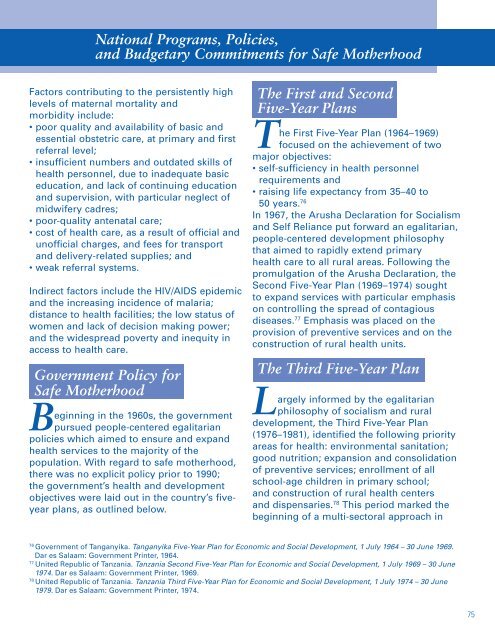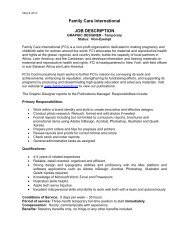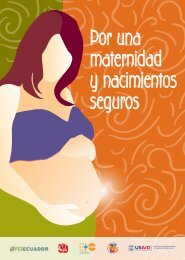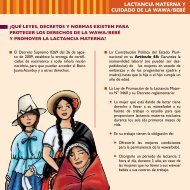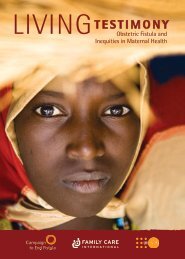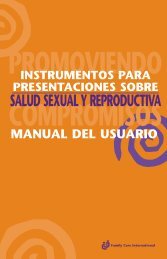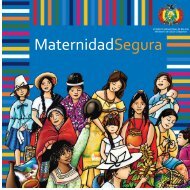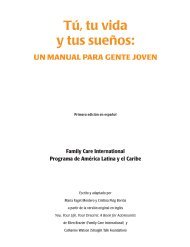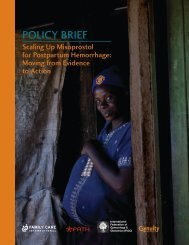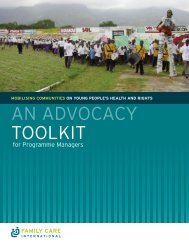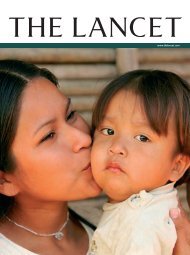Safe Motherhood: A Review - Family Care International
Safe Motherhood: A Review - Family Care International
Safe Motherhood: A Review - Family Care International
Create successful ePaper yourself
Turn your PDF publications into a flip-book with our unique Google optimized e-Paper software.
National Programs, Policies,<br />
and Budgetary Commitments for <strong>Safe</strong> <strong>Motherhood</strong><br />
Factors contributing to the persistently high<br />
levels of maternal mortality and<br />
morbidity include:<br />
• poor quality and availability of basic and<br />
essential obstetric care, at primary and first<br />
referral level;<br />
• insufficient numbers and outdated skills of<br />
health personnel, due to inadequate basic<br />
education, and lack of continuing education<br />
and supervision, with particular neglect of<br />
midwifery cadres;<br />
• poor-quality antenatal care;<br />
• cost of health care, as a result of official and<br />
unofficial charges, and fees for transport<br />
and delivery-related supplies; and<br />
• weak referral systems.<br />
Indirect factors include the HIV/AIDS epidemic<br />
and the increasing incidence of malaria;<br />
distance to health facilities; the low status of<br />
women and lack of decision making power;<br />
and the widespread poverty and inequity in<br />
access to health care.<br />
Government Policy for<br />
<strong>Safe</strong> <strong>Motherhood</strong><br />
Beginning in the 1960s, the government<br />
pursued people-centered egalitarian<br />
policies which aimed to ensure and expand<br />
health services to the majority of the<br />
population. With regard to safe motherhood,<br />
there was no explicit policy prior to 1990;<br />
the government’s health and development<br />
objectives were laid out in the country’s fiveyear<br />
plans, as outlined below.<br />
The First and Second<br />
Five-Year Plans<br />
The First Five-Year Plan (1964–1969)<br />
focused on the achievement of two<br />
major objectives:<br />
• self-sufficiency in health personnel<br />
requirements and<br />
• raising life expectancy from 35–40 to<br />
50 years. 76<br />
In 1967, the Arusha Declaration for Socialism<br />
and Self Reliance put forward an egalitarian,<br />
people-centered development philosophy<br />
that aimed to rapidly extend primary<br />
health care to all rural areas. Following the<br />
promulgation of the Arusha Declaration, the<br />
Second Five-Year Plan (1969–1974) sought<br />
to expand services with particular emphasis<br />
on controlling the spread of contagious<br />
diseases. 77 Emphasis was placed on the<br />
provision of preventive services and on the<br />
construction of rural health units.<br />
The Third Five-Year Plan<br />
Largely informed by the egalitarian<br />
philosophy of socialism and rural<br />
development, the Third Five-Year Plan<br />
(1976–1981), identified the following priority<br />
areas for health: environmental sanitation;<br />
good nutrition; expansion and consolidation<br />
of preventive services; enrollment of all<br />
school-age children in primary school;<br />
and construction of rural health centers<br />
and dispensaries. 78 This period marked the<br />
beginning of a multi-sectoral approach in<br />
76 Government of Tanganyika. Tanganyika Five-Year Plan for Economic and Social Development, 1 July 1964 – 30 June 1969.<br />
Dar es Salaam: Government Printer, 1964.<br />
77 United Republic of Tanzania. Tanzania Second Five-Year Plan for Economic and Social Development, 1 July 1969 – 30 June<br />
1974. Dar es Salaam: Government Printer, 1969.<br />
78 United Republic of Tanzania. Tanzania Third Five-Year Plan for Economic and Social Development, 1 July 1974 – 30 June<br />
1979. Dar es Salaam: Government Printer, 1974.<br />
75


